#mechanical insects
Explore tagged Tumblr posts
Text
Yellowjacket-Mimicking Moth: this is just a harmless moth that mimics the appearance and behavior of a yellowjacket/wasp; its disguise is so convincing that it can even fool actual wasps

This species (Myrmecopsis polistes) may be one of the most impressive wasp-mimics in the world. The moth's narrow waist, teardrop-shaped abdomen, black-and-yellow patterning, transparent wings, smooth appearance, and folded wing position all mimic the features of a wasp. Unlike an actual wasp, however, it does not have any mandibles or biting/chewing mouthparts, because it's equipped with a proboscis instead, and it has noticeably "feathery" antennae.
There are many moths that use hymenopteran mimicry (the mimicry of bees, wasps, yellowjackets, hornets, and/or bumblebees, in particular) as a way to deter predators, and those mimics are often incredibly convincing. Myrmecopsis polistes is one of the best examples, but there are several other moths that have also mastered this form of mimicry.

Above: Pseudosphex laticincta, another moth species that mimics a yellowjacket
These disguises often involve more than just a physical resemblance; in many cases, the moths also engage in behavioral and/or acoustic mimicry, meaning that they can mimic the sounds and behaviors of their hymenopteran models. In some cases, the resemblance is so convincing that it even fools actual wasps/yellowjackets.

Above: Pseudosphex laticincta
Such a detailed and intricate disguise is unusual even among mimics. Researchers believe that it developed partly as a way for the moth to trick actual wasps into treating it like one of their own. Wasps frequently prey upon moths, but they are innately non-aggressive toward their own fellow nest-mates, which are identified by sight -- so if the moth can convincingly impersonate one of those nest-mates, then it can avoid being eaten by wasps.

Above: Pseudosphex laticincta
I gave an overview of the moths that mimic bees, wasps, yellowjackets, hornets, and bumblebees in one of my previous posts, but I felt that these two species (Myrmecopsis polistes and Pseudosphex laticincta) deserved to have their own dedicated post, because these are two of the most convincing mimics I have ever seen.

Above: Pseudosphex sp.
I think that moths in general are probably the most talented mimics in the natural world. They have so many intricate, unique disguises, and they often combine visual, behavioral, and acoustic forms of mimicry in order to produce an uncanny resemblance.
Several of these incredible mimics have already been featured on my blog: moths that mimic jumping spiders, a moth that mimics a broken birch twig, a moth caterpillar that can mimic a snake, a moth that disguises itself as two flies feeding on a pile of bird droppings, a moth that mimics a dried-up leaf, a moth that can mimic a cuckoo bee, and a moth that mimics the leaves of a poplar tree.
Moths are just so much more interesting than people generally realize.
Sources & More Info:
Journal of Ecology and Evolution: A Hypothesis to Explain Accuracy of Wasp Resemblances
Entomology Today: In Enemy Garb: A New Explanation for Wasp Mimicry
iNaturalist: Myrmecopsis polistes and Pseudosphex laticincta
Transactions of the Entomological Society of London: A Few Observations on Mimicry
#entomology#arthropods#lepidoptera#yellowjacket-mimicking moth#wasp-moth#clearwing moths#animal camouflage#myrmecopsis polistes#pseudosphex laticincta#pseudosphex aequalis#moths#insects#bugs#mimicry#evolution#hymenopteran mimics#defense mechanisms#animal facts#wasps#yellowjackets#moths are amazing#and wildly underrated
8K notes
·
View notes
Text
#zaliva-d#total withered#wv sorcerer productions#china#techno#mechanical insects#ebm#dark electronics#2024#Bandcamp
1 note
·
View note
Text
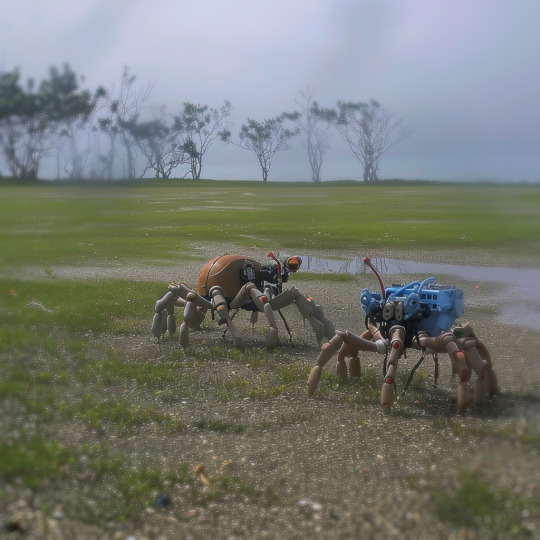
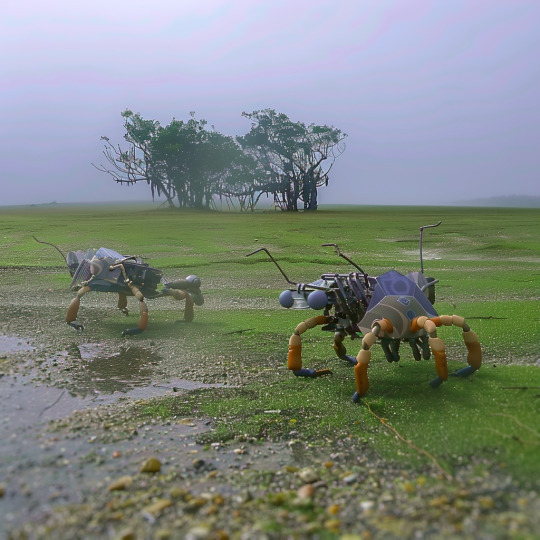

#robots#marsh#trees#fog#mechanical#futuristic#nature#exploration#swamp#innovative#robotic creatures#mechanical insects#foggy landscape#swamp exploration#nature and technology#advanced robotics#outdoor setting#futuristic machines#ai#ai generated
0 notes
Text

Some praying mantis adopts up for auction!! The bids are a little scattered across sites rn. Feel free to shoot me a dm or comment if you're interested in bidding, and AB is $75 <3
#artists on tumblr#digital art#digital illustration#art#colorful#creature#creature design#fantasy#fantasy art#fantasy illustration#praying mantis#bugblr#bugs#mantis#insect#bug#dragon#peacock#flower#mechanical#robot#open adopts#adopts#adoptables#adopt auction#design#creature art
151 notes
·
View notes
Text

FOHROK
The Brotherhood just loved its knockoffs.
Source
Creator: The-Dapper-Scrapper
#lego#bionicle#armor#armor plates#robot#robotic#robotic unit#bohrok#fohrok#knockoff#mechanical#matoran universe#brotherhood of makuta#makuta creation#insect#insectoid#machine#tubes#imitation#bricks
76 notes
·
View notes
Text






AI-Less Whumptober Day 13 - "Take Me Instead"
Insect Detective 2 - Ep. 20
Glory of Special Forces - Ep. 11
Love Mechanics - Ep. 2
Unbeatable - Ep. 27
Duel - Ep. 16
Light Chaser Rescue - Ep. 36
Previous 13/31 Next
#whump#whump gifs#asian whump#ailesswhumptober2024#whump community#whump tropes#thai drama#chinese drama#ailesswhumptober day 13#take me instead#hostage#hostage situation#improvised restraints#tape gagged#zip ties#kdrama#insect detective 2#duel kdrama#glory of Special forces#love mechanics#unbeatable cdrama#light Chaser Rescue
41 notes
·
View notes
Text
The robot lover to bug lover pipeline is so real
#mud.exe#bugs#bugblr#robots#robotblr#insects#if you enjoy robots may i suggest..bugs#its big eyes metallic colors mechanized looking parts stiff movements#being seen as creepy or uncanny#weird mouthparts#also many robot designs are directly inspired by insects!
41 notes
·
View notes
Note
Elder Bones... what if I... made a ClanGen mod based off of Better Bones.
Sure go ahead!
I hope they take that nutrition mechanic off the backburner soon, I feel like that update would be the perfect opportunity for someone to go in there with a BB-inspired mod.
#One of the Many things I'd like to do is make a 'nutrition post'#which would be like... the basis of me then delving into each clan's cuisine#I mention it a lot but RE: WindClan is seriously undernourished#Cats need a lot more fat in their diets than rabbits alone can provide#And the way BB deals with that is by treating insects as vegetables lmao#Because insects are actually much higher in fats than you realize#GOOD fats.#Plus then you could make a mod that adds intestinal parasites as a mechanic for not cooking food#Which could be a good challenge. Not only do you have to hunt but you need dedicated kitchen cats#bone babble
86 notes
·
View notes
Text
One thing people need to understand about me is that I am always role-playing. Even and especially when I'm playing board games where that's not the point. So to me, games where the mechanics have literally nothing to do with the framing device are kind of absurd.
#yesterday I played a board game called Animal Dominance#I had never played it before but it's one of my friend's favorites#the concept is basically the different animal kingdoms fighting each other for dominance over the planet#before even knowing the mechanics I demanded to play Insects#because I was already in the mindset of imagining how this would play out#and I just can't imagine any other group beating insects#reptiles won by dominating the tundra btw#so realism is not being well served here#but hey the mechanics matched the theme so I was able to get well absorbed
33 notes
·
View notes
Text
Guys what if scarabs dream shadow thing is blue because he was originally blue, like a lobster situation and he got fucking boiled somehow. Ignore how that doesn’t make sense. Just think about it, because I know we’ve been running with the whole ripped off wing situation, I think this might be interesting… I think I might have something here…..
Scarab could actually be a metallic blue. Just ignore the science behind it and embrace the blue. Trust me. Might use lobster mechanic for daydreamer AU

#lobster mechanic#that’s what I’m calling it#someone validate this idea it came to me in a haze#insects and crustaceans aren’t too far apart anyways#like the cars universe#iykyk
46 notes
·
View notes
Text

Spicebush larva with osmeterium displayed When these caterpillars are confronted an orange forked gland flicks in and out like a tongue and secretes nasty smelling material. By John Flannery on Flickr. (Hi-Res).
#larva#larvae#caterpillar#caterpillars#butterfly#butterflies#butterfly larva#butterfly larvae#spicebush swallowtail#spicebush swallowtails#papilio#papilio troilus#lepidoptera#insect#insects#animal#animals#osmeterium#defense#defense mechanism#nature#close-up#flickr
10 notes
·
View notes
Text
Snake-Mimicking Sphinx Moth (Hemeroplanes triptolemus): the caterpillars of this species are able to mimic snakes by turning upside-down and inflating the area around their head
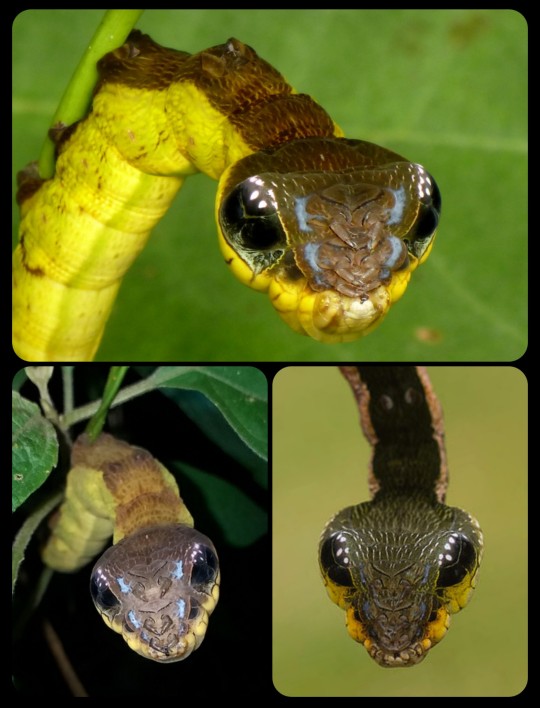
It's very common for moths to engage in mimicry during the larval stage of their development, and their caterpillars are often known to mimic snakes. In most cases, they'll simply mimic the snake's eyes (or eye) and its general morphology, but there are a few species that take their disguises to a much higher level, mimicking the snake's eyes, scaly texture, coloration, posture, and even its behavior with such a startling degree of accuracy that the tiny, harmless caterpillars are often mistaken for actual snakes.
Hemeroplanes triptolemus is probably the most famous example of this.
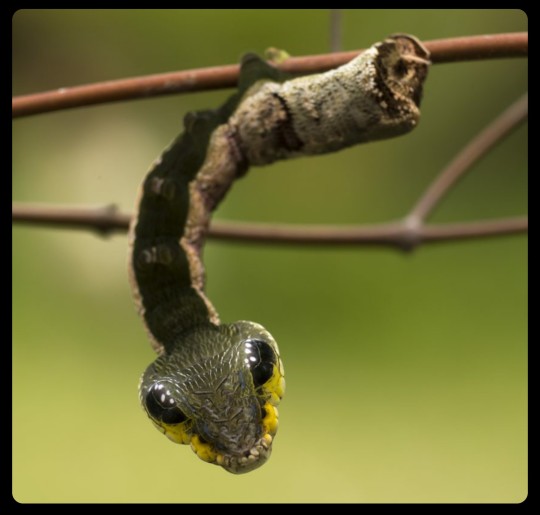
Above: a caterpillar of the species Hemeroplanes triptolemus displaying its defensive posture
This species of sphinx moth can be found in the rainforests of Central and South America. When threatened, the caterpillar suspends itself from a twig, turns its body over to expose its underbelly, tucks in its legs, and inflates the anterior segments of its body in order to mimic the shape of a serpent's head. As the body segments expand, several markings on each side of the caterpillar's body are exposed, mimicking the eyes and nostrils of a snake.
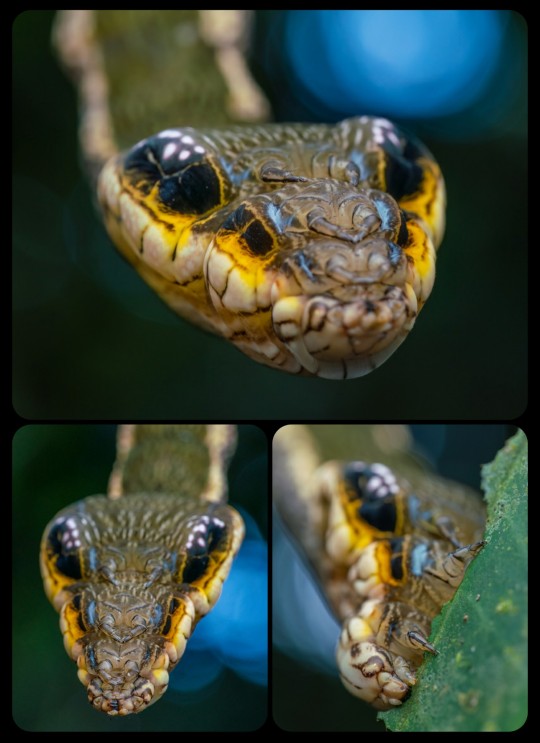
Above: the caterpillar is shown hanging upside-down; its actual head is visible near the tip of the "snake nose"
As this article explains:
At the slightest hint of danger—be it a stooping bird or pouncing lizard—the sphinx moth caterpillar begins its masquerade. Dangling from a twig, it reveals an underside patterned in faux snakeskin and eyespots that appear to glisten. By sucking in air through tiny holes in its surface, the caterpillar inflates its head to create the illusion of a triangular skull swollen with venom glands. If the shape of a deadly snake isn’t enough to startle away a hungry predator, the caterpillar will lunge as if to strike. And despite the larva’s comical lack of any actual weaponry, the strategy appears to be effective.
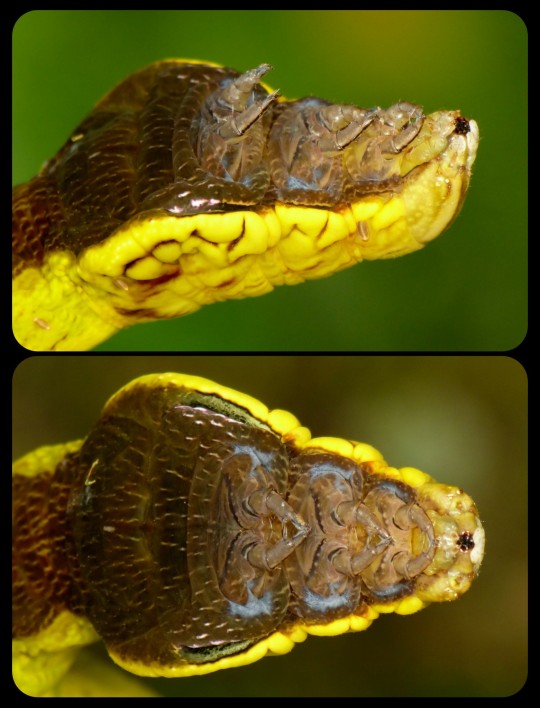
Above: detailed photos of the "snake's head"
This disguise is only present in the final instar, which is the last stage of development before the caterpillar undergoes pupation and then matures into an adult moth.
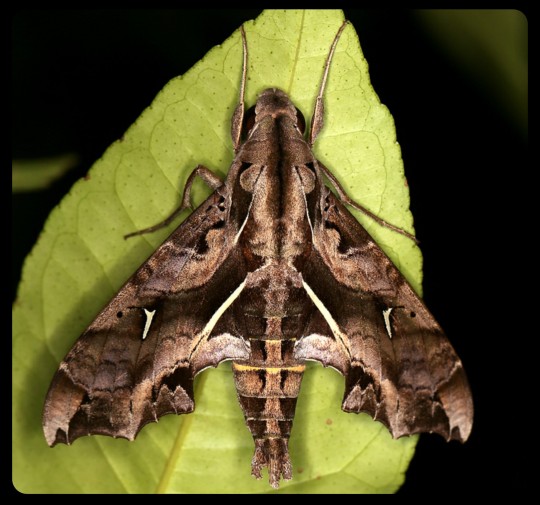
Above: the adult form of Hemeroplanes triptolemus
As I've said before, moths are some of the very best mimics in the world. I've also written posts about wasp-mimicking moths, moths that mimic jumping spiders, a moth that can mimic a broken birch twig, a moth that disguises itself as two flies feeding on bird poop, another snake-mimicking moth caterpillar, a moth that mimics a curled-up leaf, a moth that mimics a cuckoo bee, moths that mimic hornets and bumblebees, and a moth that can mimic the leaves of a poplar tree.
Sources & More Info:
BioGraphic: Snake Fake
National Geographic: This Harmless Caterpillar Looks Like a Pit Viper
Animal Behaviour: Defensive Posture and Eyespots Deter Avian Predators from Attacking Caterpillar Models
University of Nebraska: Mimicry in Insects (PDF)
Ecology and Evolution: Outstanding Issues in the Study of Antipredator Defenses
#entomology#arthropods#lepidoptera#snake-mimicking sphinx moth#hemeroplanes triptolemus#sphinx moths#caterpillars#moths#sphingidae#hawkmoths#mimicry#animal camouflage#evolution#defense mechanisms#animal facts#bugs#insects#mind-blowing moths
94 notes
·
View notes
Text









💛🤍🦊Nonbinary Tails🦊💜🖤
x/x/x x/x/x x/x/x
#tails miles prower#tails the fox#sonic the hedgehog#nonbinary#pride stim#fox#foxes#animals#gems#crystals#butterflies#bugs#insects#gears#mechanical#cake#food#stim toy#sensory toy#my stimboards#fam rq
12 notes
·
View notes
Text

Took a while, but I have another Cherrywood neighbor done-Tiki Ti! Some fun facts about this guy, which I'll put under readmore along with the rest:
-just barely over 3 feet tall thanks to the antennae
-autistic & severely anxious, though it's friends have helped a lot with that
-favorite food is sweet cheese pie
-comes from a family of honeypot ant ranchers, which is where his love of ants comes from
-at roughly the equivalent of 20 human years old, it's one of the youngest neighbors
-extremely pretty by Centicarr standards, to the point where people sometimes think he's a supermodel
-has a pair of beetle wings under the rear elytra, but is too scared to ever try flying

Eddie was one of the first of Home's residents to meet any of them, and naturally it was quite a shock when a guy made of bugs walked in! He does over time learn to tolerate and even somewhat enjoy Tiki's presence though- he has to, since a mutual love of insects means that Frank's new bestie is often over at their house. The others have a bit of an easier time getting along with their new buggy pal, although in a similar fashion to Eddie Sally's presence and intensity do end up taking some time to get used to.


I'll leave y'all with a final sketch of Tiki teaching Frank his native language, Chitter, which although they lack the mouthparts to speak fluently can be modified to the point of being understood.
youtube
#I told y'all these guys were gonna get weird lol#they are aliens after all#welcome home#welcome home oc#Cherrywood#Ember's art#alien#bug#insect#centaur#pink#purple#puppet oc#no idea how this guy would be operated#gotta be a mechanical nightmare tbh#stuff i said#Youtube
7 notes
·
View notes
Text
thinking about Tron program bodies again, blood is not enough for me, where are the wires and fans and plates of metal that bend and snap
I have this vague image of an anatomical diagram of a program
Energy Circulatory System - the Blood, also the digestive track bc they don't have food, Mouth to throat tube to processor located center, near the disk port, it processes and then pumps the energy through the lightlines of the body, if a program overclocks themselves enough, they can suffer burnt or even ruptured circuitry
Energy both fuels the program and cools them off, when cooling processes are activated, the energy will be cooled off by nearby venting processes and will then be circulated throughout the body
Venting System - Similar looking to lungs, two fans that sit within the upper chest, one on each side, subtle ducts can open along the sides of a program to release extra heat (they sorta look like gills, ticklish), Most of the cooling is done through this system, Vents work to expell air through the nose, mouth, and additional vents and ducts, some programs have extra vents for their functions (Mechanic need more bc they work in hotter environments)
The Disc Port - connected directly to the morherboard of the program, this is why if programs are hit there, they will derezz, sorta like a brain (head wounds are not fatal), all processors are connected via wires to the board
Processors - part of the motherboard, eyes, ears, nose, tongue, all the senses are split up into different processing units, These usually have a mechanical unit, like eyeballs, that connect to the board with long thin wires, essentially the nervous system, but centered around the disc not the head
Internal Systems - internal sensors and diagnostics that regulate the body, the Endocrine System, Connected to a programs personal display, will update with warnings and display whatever parameters needed about the body
"Bones" - programs don't have bones, but they do have metal tubes that house their more delicate pieces (wires), Some programs (security) have more reinforcement around vulnerable areas, like the throat and chest, with the plating sometimes even being above the skin, Additonal plating can be added to the forearms and calves without much modification, further integrated armor is an arduous process
Derezzing is still a thing, parts of a program will maintain integrity to a point, then they collapse into voxels, Not all pieces will derezz, if that threshold isn't met, the pieces will remain in their form, basically, if you want to fully derezz a program you have to grind them into voxels, otherwise the bones and other stuff are unlikely to derezz until the energy runs completely out (usually a few days, or the Grid equivalent), where they will then turn into a pile of voxels
Voxels and Energy both evaporate, losing their vivid technicolor hues, until they turn a dark soot grey, at this point they disappear leaving a thin dusty film behind, it's hard to clean and slippery
#does this count as gore???#btw idk how computers work so Im just making this up#If you have suggestions or info on how computers actually work please add bc it would be cool#Tron hc#I guess?#I want programs to have adaptations that fit their function and environment better#mechanics who work in tight and hot spaces with additonal vents and more efficient venting processes#Security with additional armor like an insect carapace#Medics with advanced processors and sensors for diagnostic purposes#aerial programs with better energy circulatory systems to cope with the forces
9 notes
·
View notes
Text
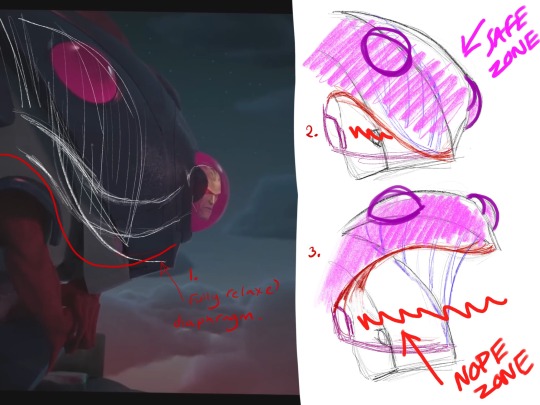
Been fixating on how Final Form’s laser chest weapon works. He’s got a lot of organic stuff going on as well so here’s my idea - feel free to ask questions if it’s not clear enough.
Kinda feel like using the chest cannon is a last resort for him, probably gives him stitch or something as well as depleting loads of energy
#mandroid final form tfe#transformers mandroid#art#digital art#my art#transformers earthspark#sketch#tfe mandroid#illustration#tfe dr meridian#he is so interesting wtf#i can’t fucking stop drawing the greasy bastard#mad scientist turns himself into a mechanical insect#madness this dude
24 notes
·
View notes